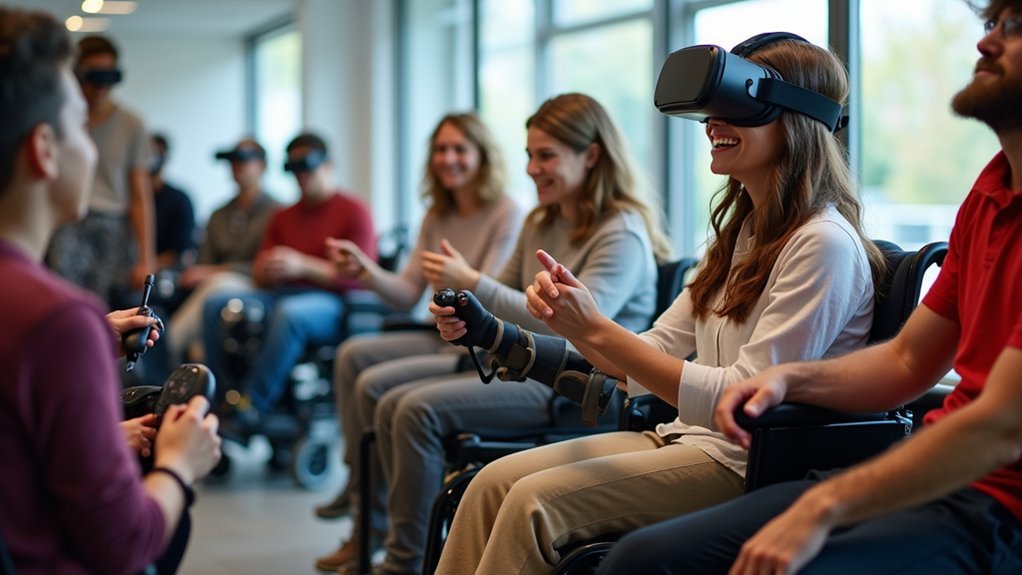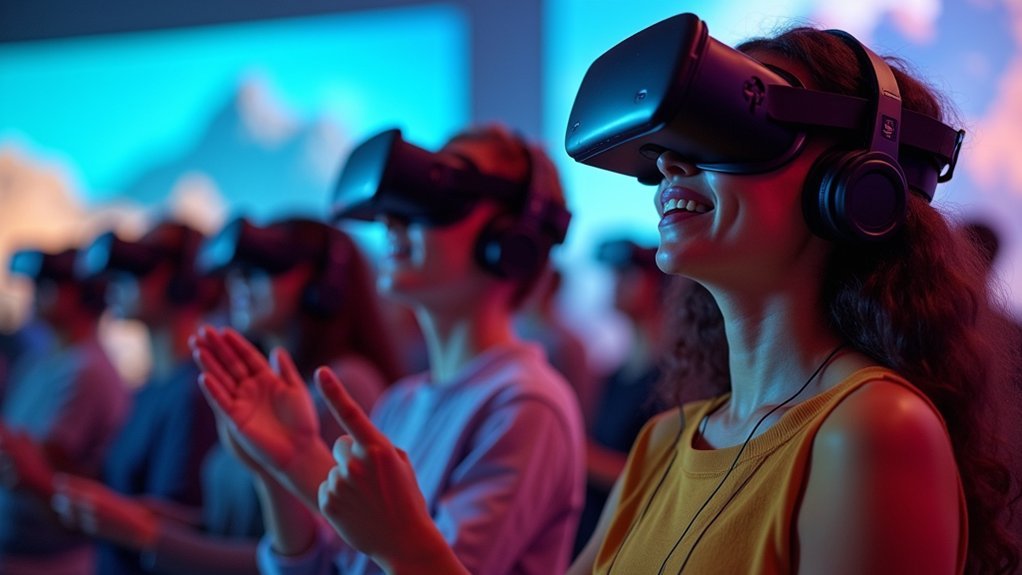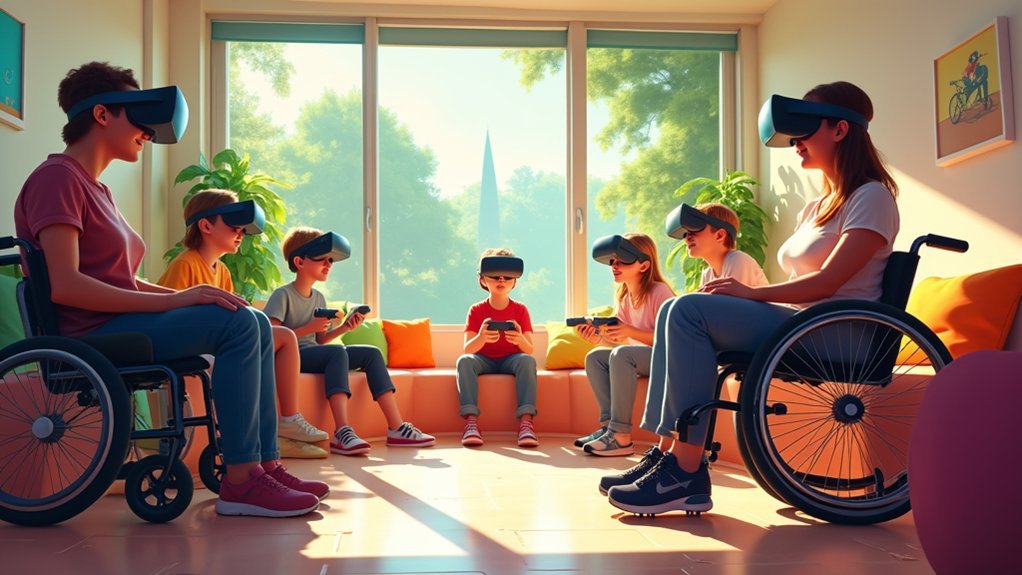You can experience immersive virtual reality regardless of your physical abilities when developers prioritize inclusive control solutions that adapt to diverse needs. Eye-tracking technology eliminates traditional handheld controllers, while voice commands provide hands-free navigation for users with mobility impairments. Adaptive controllers feature customizable button mapping, adjustable sensitivity settings, and programmable switches that accommodate unique requirements. Brain-computer interfaces and gesture recognition create personalized control schemes that enhance accessibility and engagement for all users seeking immersive experiences.
Understanding VR Input Accessibility Challenges

When you enter a virtual reality environment, you expect seamless interaction with digital worlds, but traditional input methods create significant barriers for users with disabilities. Handheld controllers present major challenges if you have mobility impairments, limiting your ability to navigate virtual spaces effectively.
You’ll find that visual impairments compound these difficulties, as standard systems don’t provide adequate auditory feedback for spatial awareness. The lack of standardized accessibility features across platforms means you can’t rely on consistent control options.
However, adaptive input devices like eye-tracking and voice commands offer promising solutions. When developers implement customizable control schemes, your user experience improves dramatically. This highlights why inclusive design isn’t optional—it’s essential for creating VR experiences that truly serve everyone’s needs.
Adaptive Controller Design for Physical Disabilities
While traditional VR controllers assume standard hand mobility, adaptive controllers revolutionize how you interact with virtual environments when you have physical disabilities. These innovative devices accommodate your unique needs through customizable layouts and personalized configurations.
Adaptive controllers enhance inclusive VR through:
Adaptive controllers break down barriers in virtual reality by creating personalized, accessible gaming experiences for users with diverse physical abilities.
- Alternative input methods like large buttons, touchpads, and motion sensors for users with limited dexterity.
- Haptic feedback technology that provides tactile responses, improving spatial awareness for visually impaired users.
- Customizable interfaces that let you configure inputs based on your specific mobility requirements.
- Collaborative design approaches involving disability advocates to meet accessibility standards.
Research demonstrates these solutions considerably boost user engagement and satisfaction.
Eye-Tracking Technology as Alternative Input
When you look at objects in a VR environment, eye-tracking technology translates your gaze into precise input commands, eliminating the need for traditional hand controllers.
You’ll find this technology particularly transformative if you have limited mobility, as it provides hands-free navigation through gaze-based selection and dwell-time activation.
While implementing eye-tracking systems presents technical hurdles like calibration accuracy and latency issues, developers are addressing these challenges to create more responsive and reliable alternative input methods.
How Eye-Tracking Works
Eye-tracking technology transforms how you interact with virtual environments by precisely monitoring your gaze direction through sophisticated infrared light systems.
This innovation creates powerful accessibility features for users with mobility impairments who need alternative input methods for immersive experiences.
The technology operates through four key components:
- Infrared illumination – Invisible light sources illuminate your eyes without causing discomfort
- Reflection capture – High-speed cameras detect light reflections from your cornea and pupil
- Gaze calculation – Advanced algorithms process reflection patterns to determine your exact looking direction
- Real-time tracking – Systems achieve accuracy within degrees of visual angle for precise interactive experiences
This process enables gaze-based selection, allowing you to navigate and control virtual objects simply by looking at them, creating truly personalized VR experiences.
Accessibility Benefits Overview
Since traditional VR controllers require precise hand movements and complex button combinations, they often create barriers for users with mobility impairments or limited dexterity. Eye-tracking technology transforms this landscape by offering an alternative input method that’s both intuitive and accessible. You’ll find that simply looking at virtual elements allows seamless interaction without physical strain.
| Traditional Controllers | Eye-Tracking Technology |
|---|---|
| Requires hand dexterity | Gaze-based control |
| Complex button mapping | Intuitive looking |
| Physical fatigue | Reduced physical strain |
| Limited accessibility | Enhanced accessibility |
| Excludes some users | Includes users with disabilities |
When combined with speech recognition, eye-tracking creates hands-free navigation that makes VR experiences truly immersive. This enhanced engagement guarantees that users with disabilities can enjoy the same level of interaction and enjoyment as traditional users.
Implementation Challenges Addressed
Although eye-tracking technology offers significant accessibility advantages, you’ll encounter several implementation challenges that developers must address to create truly inclusive VR experiences.
- Hardware Calibration Complexity – You’ll need to guarantee eye-tracking technology works accurately across diverse users with varying visual capabilities and mobility impairments.
- Software Integration Barriers – Creating accessible VR experiences requires seamless integration between eye-tracking systems and existing VR platforms without compromising performance.
- User Training Requirements – Users need time to adapt to eye-controlled navigation, potentially affecting initial user engagement levels.
- Cost and Scalability Concerns – Balancing affordability with advanced features while maintaining quality poses significant implementation challenges.
Despite these obstacles, advancing technology continues making eye-tracking more viable for delivering personalized experience solutions in inclusive VR experiences.
Voice Command Integration in VR Systems

When you’re maneuvering a virtual environment with limited hand mobility, voice command integration transforms your VR experience from frustrating to empowering. Advanced speech recognition technology interprets your natural language, creating seamless interactions without traditional input devices. You’ll find yourself steering through menus, selecting options, and manipulating virtual objects through simple vocal commands.
| VR Platform | Voice Features |
|---|---|
| Oculus | Menu navigation, object selection |
| HTC Vive | Command execution, accessibility options |
| PlayStation VR | Voice shortcuts, hands-free controls |
This accessibility enhancement greatly benefits users with mobility impairments while boosting user engagement across all demographics. Research confirms that voice control reduces interaction barriers, improving satisfaction in VR experiences. You’re no longer limited by physical constraints when exploring virtual worlds.
Brain-Computer Interface Solutions for VR
As technology advances beyond traditional controllers and voice commands, brain-computer interfaces (BCIs) represent the next frontier in accessible VR control.
Brain-computer interfaces are revolutionizing VR accessibility by enabling direct thought-based control, transcending the limitations of traditional input methods.
These revolutionary systems enable direct communication between your brain and VR environments, allowing you to control virtual worlds through thought alone.
BCIs particularly benefit users with mobility impairments by providing an alternative input method that bypasses physical limitations.
Here’s how BCI solutions enhance VR accessibility:
- Real-time processing at speeds up to 1000 Hz guarantees smooth, responsive interactions
- Machine learning algorithms adapt to your unique neural patterns for improved customization
- Reduced fatigue compared to traditional methods increases your engagement levels considerably
- Hyper-personalized experiences cater to your individual needs and cognitive abilities
This technology transforms immersion by making VR truly accessible to everyone, regardless of physical capabilities.
Haptic Feedback Customization Options
While neural interfaces represent cutting-edge accessibility, haptic feedback customization offers immediate, practical solutions that transform how you experience touch and sensation in virtual reality.
You can adjust vibration intensity, duration, and patterns to match your specific needs and preferences. This immersive experience becomes particularly valuable if you’re dealing with accessibility issues.
Users with sensory sensitivities can reduce overstimulation by fine-tuning haptic settings, while advanced adaptive actuators simulate realistic textures for enhanced spatial awareness.
If you have hearing impairments, customizable haptic cues translate audio signals into tactile sensations.
Research confirms that personalized haptic feedback increases engagement and satisfaction, making inclusive content accessible to diverse audiences regardless of varying abilities.
Switch-Accessible VR Control Systems
Switch-accessible VR control systems revolutionize virtual reality for users with limited mobility by transforming how you interact with digital environments.
These adaptive switches can be customized to match your specific needs and preferences, opening doors to previously inaccessible experiences.
Adaptive switches unlock virtual worlds by tailoring controls to individual abilities, transforming inaccessible digital experiences into personalized interactive adventures.
You’ll discover four key advantages of these inclusive systems:
- Customizable mapping – Software allows you to assign switch inputs to specific in-game actions
- Versatile switch types – Choose from button switches, joystick switches, or sip-and-puff devices
- Enhanced accessibility – Participate in gaming, education, and therapeutic VR environments
- Seamless integration – Works within popular VR applications without compromising functionality
Ongoing technological developments continue improving responsiveness and functionality, ensuring you’ll experience immersive virtual environments regardless of physical limitations.
These systems truly enhance inclusivity in VR.
Gesture Recognition for Limited Mobility Users
After exploring switch-based controls, you’ll find gesture recognition opens new possibilities for VR interaction when you have limited mobility.
These systems adapt to your specific range of motion, creating personalized control schemes that work with whatever hand movements you can comfortably make.
You can customize everything from simple finger gestures to alternative hand positions, ensuring the technology fits your unique abilities rather than forcing you to adapt to rigid input requirements.
Adaptive Gesture Recognition Systems
As you navigate VR environments, adaptive gesture recognition systems transform how you’ll interact with virtual worlds by interpreting your unique range of movements through sophisticated sensors and machine learning algorithms.
These systems enhance accessibility by customizing recognition patterns to your specific capabilities, ensuring individuals with disabilities can fully engage with immersive environments.
Key benefits you’ll experience include:
- Personalized gesture mapping that adapts to your easier-to-perform movements
- Enhanced user engagement through intuitive control methods beyond traditional controllers
- Haptic feedback integration providing tactile responses for more immersive interactions
- Multi-modal input support using facial expressions, eye movements, or minimal upper body motions
This technology greatly improves your VR experiences by creating truly inclusive control solutions that respond to your individual needs and capabilities.
Customizable Motion Input Methods
When traditional VR controllers become barriers rather than bridges to virtual worlds, customizable motion input methods offer you revolutionary alternatives that recognize your unique physical capabilities.
These adaptive gesture recognition systems let you tailor sensitivity settings and recognition parameters to match your specific mobility needs, ensuring you’re not excluded from immersive environments.
You’ll find that gesture recognition technology adapts to various hand movements, facial expressions, and body positions that work within your range of motion.
Advanced machine learning algorithms continuously learn your patterns, improving accuracy over time. This personalization greatly boosts user engagement among limited mobility users, creating truly inclusive experiences.
Companies now prioritize accessibility by integrating these customizable systems, ensuring you can fully participate in virtual worlds regardless of physical limitations.
Alternative Hand Control Options
While standard VR controllers require precise grip strength and finger dexterity, gesture recognition technology transforms how you navigate virtual environments through natural hand movements alone.
This accessibility breakthrough provides alternative hand control options for users with limited mobility, creating truly interactive VR environments.
Advanced sensors track your hand positions in real-time, offering:
- Customizable gesture patterns that adapt to your specific physical capabilities
- Intuitive control methods that eliminate traditional controller dependencies
- Reduced physical strain during extended VR sessions
- Seamless interaction across various virtual applications
You’ll find these inclusive solutions increasingly integrated into mainstream VR platforms.
The technology recognizes diverse gesture types, accommodating individual preferences while maintaining responsive performance.
This accessibility advancement guarantees everyone can experience immersive virtual worlds comfortably.
Mouth and Tongue Control Interfaces
Though traditional VR controllers require hand dexterity that many users don’t possess, mouth and tongue control interfaces open new pathways for immersive interaction. These innovative input methods utilize advanced sensors to detect precise oral movements, translating them into VR commands for users with mobility impairments.
You’ll find these accessibility solutions enable full engagement in virtual environments previously difficult to navigate. The technology transforms subtle tongue gestures and mouth movements into responsive controls, creating truly immersive experiences.
Haptic feedback technology enhances these interfaces by providing sensations that correspond to your inputs, making interactions feel natural and intuitive. As developers continue refining accuracy and reducing latency, these inclusive solutions are becoming more comfortable and reliable, ensuring VR gaming remains accessible to everyone regardless of physical limitations.
One-Handed Operation Solutions
You’ll find that adaptive controller design forms the foundation of effective one-handed VR operation, with manufacturers creating ergonomic devices that consolidate essential functions into accessible button layouts.
Gesture-based navigation systems complement these controllers by letting you move through virtual environments using natural hand movements and pointing motions.
Voice command integration rounds out these solutions, enabling you to execute complex actions and menu selections through spoken instructions when physical inputs aren’t practical.
Adaptive Controller Design
Because traditional VR controllers require two-handed operation, users with mobility impairments often face considerable barriers when trying to access virtual environments.
Adaptive controllers revolutionize this experience by providing inclusive solutions specifically designed for one-handed operation.
These innovative devices transform VR accessibility through:
- Customizable layouts that adapt to your specific physical needs and preferences
- Programmable buttons you can configure for optimal control schemes
- Haptic feedback technology that provides tactile sensations for enhanced immersion
- External input ports that accommodate switches and specialized devices
Research demonstrates that implementing these adaptive solutions greatly boosts user satisfaction and engagement.
Companies like Microsoft lead this inclusive design movement, proving that accessible VR isn’t just possible—it’s essential for creating truly universal virtual experiences.
Gesture-Based Navigation Systems
While adaptive controllers offer excellent customization options, gesture-based navigation systems take VR accessibility even further by eliminating the need for handheld devices entirely. These systems use advanced motion tracking technology like infrared sensors to interpret your natural hand movements, making VR experiences more accessible for users with limited mobility or those requiring one-handed operation.
| Feature | Benefit |
|---|---|
| Motion Tracking | Interprets natural gestures |
| One-Handed Operation | Accommodates mobility limitations |
| Haptic Feedback | Provides tactile confirmation |
You’ll find these intuitive controls considerably boost engagement and satisfaction. The gesture-based navigation systems welcome users who struggle with traditional controllers, while haptic feedback enhances your understanding of virtual interactions through tactile responses that confirm your movements within the environment.
Voice Command Integration
Voice command integration transforms VR accessibility by enabling you to control virtual environments through natural speech, eliminating barriers for users with mobility limitations or those requiring one-handed operation.
This immersive technologies breakthrough guarantees individuals with mobility impairments can fully participate in virtual experiences.
Voice-controlled systems enhance your VR interaction through:
- Natural Language Navigation – You’ll move through virtual spaces using simple spoken commands
- Hands-Free Selection – Voice commands let you select objects and execute actions without controllers
- Increased Engagement – You’ll experience greater freedom and enjoyment without physical constraints
- Universal Accessibility – Robust speech recognition accommodates diverse accents and speech patterns
Voice command integration creates inclusive virtual environments where accessibility doesn’t compromise functionality, affirming everyone can engage meaningfully with VR content regardless of physical capabilities.
Configurable Button Mapping and Sensitivity
One of the most impactful ways VR systems can embrace inclusivity is through configurable button mapping and sensitivity controls that adapt to each user’s unique needs.
These features allow you to customize control schemes based on your physical abilities and motor skills, creating truly inclusive experiences.
Customizable controls adapt to your unique physical needs, making VR truly accessible for everyone.
You can remap buttons to assign frequently used actions to easier-to-reach triggers or controllers. Sensitivity settings let you fine-tune how responsive controls are to your movements, particularly beneficial if you have limited dexterity.
Modern VR systems now prioritize these accessibility options.
User-friendly interfaces make customization straightforward, empowering you to create a personalized VR experience.
This configurable button mapping greatly reduces barriers for players with disabilities, ensuring everyone can enjoy immersive virtual environments comfortably.
Motion Amplitude Adjustment Features
Beyond button customization, motion amplitude adjustment features give you precise control over how much physical movement VR experiences require from your body.
These customizable motion settings transform accessibility by letting you tailor movement intensity to match your physical capabilities and comfort levels.
Motion amplitude adjustments create an inclusive VR environment through:
- Reduced motion sickness – You’ll experience fewer vestibular issues when controlling movement ranges
- Enhanced accessibility – Users with disabilities can participate fully in immersive experiences without physical strain
- Improved satisfaction – Customizable settings boost your overall engagement and enjoyment
- Integrated compatibility – These features work seamlessly with haptic feedback and adaptive interfaces
Multi-Modal Input Combination Strategies
When you combine multiple input methods like voice commands, gesture recognition, and traditional controllers, you create a VR environment that adapts to your unique abilities and preferences.
Multi-modal input systems greatly boost accessibility by accommodating users with various disabilities, whether you’re managing mobility impairments or cognitive challenges. You’ll find these strategies enhance user engagement because you can select the input method that feels most natural and comfortable.
Adaptive algorithms within these systems learn your behaviors and preferences, delivering a truly personalized VR experience.
When developers integrate eye-tracking and haptic feedback with traditional controls, you’ll experience dramatically improved interaction quality. This combination creates a more immersive experience that welcomes everyone, regardless of their physical capabilities or technological comfort level.
Frequently Asked Questions
What Is One Way a VR Work Meeting Could Be More Inclusive?
You can implement real-time captioning and transcription services during your VR work meetings, ensuring colleagues who’re deaf or hard of hearing can fully engage with discussions and participate equally in conversations.
What Is VR Treatment for ADHD?
VR treatment for ADHD uses immersive environments where you’ll practice attention skills through gamified scenarios. You’ll receive immediate feedback and rewards, helping you improve focus, task completion, and executive functioning in controlled, adaptable settings.
What Is VR Training at Walmart?
You’ll experience immersive simulations at Walmart that prepare you for real-world scenarios through VR training. You’ll practice customer service, safety protocols, and operations while receiving real-time feedback to improve your skills effectively.
What Is Google’s Affordable VR Solution?
Google’s affordable VR solution is Google Cardboard, launched in 2014. You’ll use your smartphone with a simple cardboard viewer to experience virtual reality without expensive headsets, making VR accessible to everyone.
In Summary
You can transform VR from an exclusive technology into an inclusive platform by implementing these diverse control solutions. Whether you’re designing adaptive controllers, integrating eye-tracking, or combining multiple input methods, you’re creating opportunities for everyone to experience virtual worlds. Don’t let physical limitations define who gets to participate in VR. Start implementing these accessibility features today, and you’ll build truly inclusive experiences that welcome all users.





Leave a Reply